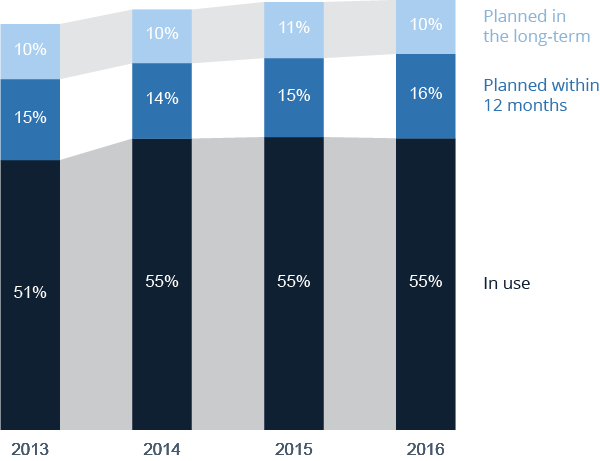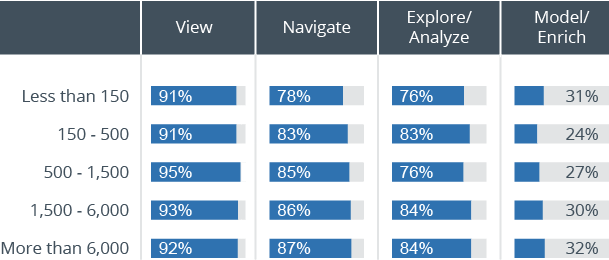Self-Service BI: An Overview
Are you looking for further assistance on this topic? You will find it here.
Self-service business intelligence (BI) has been on organizations’ wish lists for a long time, and data from the BARC BI Trend Monitor 2017 confirms that it is still a high priority. The ever-growing demand is a result of business users’ need for more flexibility and self-reliance in reporting and analysis.
What Is Self-Service BI?
Self-service BI is a trend with a somewhat vague definition. In the most general sense, self-service BI tasks are those that business users carry out themselves instead of passing them on to IT for fulfillment.
The aim is to give the users of BI tools more freedom and responsibility at the same time. At its heart lies the notion of user independence and self-sufficiency when it comes to the use of corporate information, which leads to a decentralization of BI in the organization.
Beyond this rather broad definition, self-service BI has many facets. Its meaning depends very much on the specific requirements of particular user roles. For each role, self-service BI can help users accomplish various tasks.
For example, casual BI users often only need to be able to filter and group data. In the very same environment, power users or business analysts might have to integrate local data from different sources on their own so they can quickly build or enhance existing reports. Therefore, the need for self-service within a BI environment varies according to user requirements.
Typical users can be assigned to three roles which, in reality, overlap and change according to the task at hand:
- Casual or standard users make up roughly 70 percent of all BI users. Usually, they have a rather limited BI skillset which corresponds with their straightforward requirements. Therefore, analysis, dynamic reports and dashboards are sufficient to cover their self-service BI needs in most cases.
- Power users make up around 25 percent of all users (typically much less in larger BI environments). They are skilled BI users who need a lot of flexibility and functionality for their daily work with data to answer their business problems. Suitable self-service tools allow them not only to analyze data but to change existing (or even create new) reports and dashboards from scratch.
- About 1 to 5 percent of all BI users can be described as business analysts. These are the users with the most advanced BI skills and requirements. They have the highest demand for flexibility and functionality in their self-service BI solutions. For them, self-service must cover tasks like data exploration, modeling and deploying a sandbox environment for special use cases.
As described above, the requirements of business users for self-service are extremely diverse and range from free analysis and modification of reports to integration of local data and even to changing semantic models. These requirements can be categorized as follows:
Modification of Reports and Dashboards
The use of self-service business intelligence tools enables business users to modify reports and dashboards. Users can filter or produce reports visualizing their key indicators in the most meaningful way. They can independently create analyses specially addressing their particular needs and therefore derive new insight from relevant business processes. Furthermore, reports can easily be adapted. In this way, self-service functions provide users with a higher level of flexibility in the creation of analysis and reports.
Modification of Reports and Dashboards
The creation of reports and dashboards no longer needs to be the sole task of IT. Thanks to intuitive tools and predefined report templates and dashboards objects, power users can create ad hoc reports and dashboards to support other end users (usually within their line of business) themselves.
Integration of Private, Local Data
A further requirement often associated with the self-service philosophy is the integration of private, local data into existing reports, analyses or data models. Such data can come from Excel documents, flat files or other external sources.
Self-service functions help business users to quickly integrate data into reports. Local data can be used to extend the information delivered by the data warehouse limiting the pressure and workload on data management.
Modification or Creation of Data Models
For power users or business analysts in certain environments, self-service must provide the possibility to modify or produce data models independently. Business users act as ‘data modelers’, adapting their semantic model to a business department’s needs without relying on IT or BICC involvement. Modeling can take place in a metadata layer, a database or a so-called ‘sandbox’ (a confined environment). Each company should define its own data management strategy to determine the best approach to be used.
Why Is Self-Service BI So Important?
In many companies, business intelligence is traditionally based on a central data warehouse or centrally deployed data marts. However, the methods, architectures and software solutions that have been considered best practice in data warehousing for a long time are now insufficient to meet the growing needs of many of today’s companies.
One of the reasons why companies increasingly adopt self-service solutions is to address the challenge of business departments to have access to data and information anytime and anywhere. To keep ahead of the competition, companies need to act as quickly as possible on new insights gleaned from analytics. Traditional BI delivery models, still suitable for many situations, cannot offer the level of agility and efficiency that quickly changing requirements demand. Since data volumes and sources are growing all the time, an iterative approach (i.e., trial and error) to analysis is required to find new promising business use cases and to leverage the full economic value of the data at hand.
As a result, demand for simple, quick and user-friendly BI software solutions is still on the rise and has been for years. Enterprises are striving to enable business users to build or design their queries, reports, interfaces and even data models. Power users are even compiling their dashboards using layout components from different sources, adjusting and combining them for their own use and more often for the needs of their teams.
An Important Trend in Nearly Every Company
Almost all respondents who contributed to the 2017 BARC BI Trend Monitor see self-service BI as an important trend. This is a picture that hasn’t changed for years.
Importance of Self-Service BI in 2017 (n=2,680)

Only Southern and Northern Europe, as well as the telecommunications industry are lagging slightly behind.
Conversely, best-in-class, South American and Eastern European companies put more emphasis on the topic compared to their competitors.
There are a few noteworthy changes compared to the previous year:
- While consultants and vendors see self-service BI as slightly more important, the figures for business and IT users remain unchanged.
- In financial services and utilities, there is an increase in importance, but we are seeing a decrease in the manufacturing and public sectors.
- While the importance of self-service BI is rising in South America and Europe, it is falling in North America.
- There is a major increase in importance in Eastern Europe and France.
The Adoption Rate Is Stagnating
Surprisingly, over the last few years, the adoption rate of self-service BI hasn’t changed – despite about 15 percent of BI Survey respondents saying every year they will implement self-service BI over the next 12 months. The percentage of respondents using self-service BI tools has remained unchanged at about 55 percent since 2014.
This is rather unexpected considering the high level of importance companies attach to self-service BI. But the reason for this is probably mostly a labeling issue. Since most solutions now support self-service BI use cases and the marketing buzz around it has faded, many users are using these kinds of functions on a regular basis and perhaps aren’t aware of the term self-service BI.
Self-Service BI Usage

Which Tasks are Business Users Performing?
When analyzing the self-service BI tasks users are performing across different company sizes, we see a similar rate for “View” tasks. However, the rate drops off for “Navigate” and “Explore/Analyze” tasks at the smallest companies. For the most advanced task of “Model/Enrich”, the largest companies report the highest rates of use. Curiously, the second highest rate for “Model/Enrich” occurs in the smallest companies. Factors that may explain these results could be the higher numbers of “business analysts” typically found at large organizations as well as the choice of newer BI tools with more intuitive interfaces often selected by smaller organizations.
Business user tasks by company size (n=2,285)

The (Promised) Benefits of Self-Service BI
Self-service BI can offer many advantages to business users drowning in data but starved of information. The central promise of self-service is to improve agility and flexibility in business departments by increasing user independence from IT departments. At the same time, IT’s workload for simple tasks is reduced, enabling resource-drained IT departments to focus on tasks with a higher value add for their organization (e.g. modeling user-friendly data marts).
The flexibility self-service BI gives users when working with new or existing information is highly valuable. Used correctly, self-service BI enables business users to create the specific reports they need to tackle challenging business problems in a timely fashion.
The reduced dependence on external resources allows business users to produce information and insight far more efficiently. Efficiency is gained mostly by skipping the tedious translation process for business requirements. On the other hand, companies can glean insight from data efficiently by allowing iterative processes that are not possible in traditional environments. In this way, companies can make sound decisions based on data quicker than before, to outpace their competition.
At the same time, IT staff don’t have to deal with constantly changing requests from other departments for new queries and reports. Liberated from these responsibilities, they can devote their working time to other more productive tasks.
Challenges of Self-Service BI
In theory, this all appears to be relatively straightforward but, in practice, there are some serious problems and risks.
Self-service BI places additional strain on companies’ BI organizations and BI governance as the responsibility for reporting becomes increasingly scattered. This can result in various differently prepared data sets, data inconsistencies, mistakes in analysis, falling data quality or the development of data silos.
The risks that arise are:
- Resources aren’t used efficiently enough
- Compliance and legal requirements aren’t fulfilled
- The quality and efficiency of the entire corporate management is affected
- The ability to innovate and compete with the help of analytics can be compromised
In many cases, self-service BI initiatives lead to the exact opposite of what they were set up to accomplish: to make better decisions quicker. Therefore, striking the right balance between flexibility and setting and adhering to certain data and analytical standards is a crucial element in the success of self-service BI projects. Standards become vital to aligning the efforts of scattered power users.
The tension between over-stringent standards and local flexibility can only be solved by implementing data governance policies that are accepted and adhered to by all. The objective is to supply the user with self-service functions and tools, and at the same time establish a concept for acceptable governance.
Governance should include specific methods and procedures for the handling, control and consistency of data to make the most of the information contained in the data and ensure its best possible use for business processes.
When defining governance policies for self-service BI, we recommend considering the following key points:
- Self-service only makes sense if speed increases without compromising trust in data.
- Easy access and understanding of the data are preconditions for successful self-service in business departments.
- Explorative and traditional BI use cases have different requirements in terms of architecture and governance, resulting in a different balance between flexibility and control.
Self-Service BI Tools Must Meet User Requirements
When it comes to finding the most suitable self-service BI tool for your company, it is crucial that your solution is exactly tailored to the specific skills, interests and information requirements of your business users. Depending on the user type (business analyst, power or casual user) and their needs, a very different BI tool may be preferable.
In some cases, this can be an interactive dashboard or an ad hoc reporting tool. In others a visual discovery, guided advanced analytics, or self-service data preparation tool is needed.
One of the most important criteria that needs to be covered is the ability to provide role-specific functions. The crucial point here is to address the needs of two groups within the company. On the one hand, power users and business analysts with their knowledge of analyzing data and creating reports need to be satisfied. It is also vital to secure buy-in from end users, who often need business intelligence tools exclusively for easy creation of analyses and ad hoc reports.
Check out the BI User Review Matrix to get a comparison of the leading (self-service) BI software solutions on the market.









